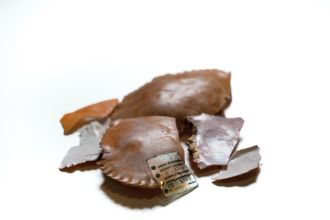Media release
From:
Turning seafood waste into sustainable wearable health sensors
QUT researchers have created a prototype electronic device using a material made from seafood waste, paving the way for safe, flexible and sustainable wearable health sensors.
A team from the QUT Centre for Materials Science has demonstrated that chitosan, a naturally derived, biodegradable biopolymer recovered from seafood waste such as Red Claw shrimp, Rock lobster and squid, can be used with a high-performance conducting polymer film to create a new class of wearable electronic transistors.
The medical-grade polymer samples were supplied by Sunshine Coast-based industry partner Biomedical Chitosan.
The research, published in Small Structures, is a step towards the development of wearable biocompatible biosensors which could be able to monitor health in real-time without compromising comfort, safety or the environment.
Lead researcher Professor Prashant Sonar said the study was a significant step in building the next generation of wearable biomedical devices using sustainable electronic approach.
“We have successfully shown that a film made from chitosan, a biopolymer derived from seafood waste, when coated with a conducting polymer, can act as the foundation for flexible transistors,” Professor Sonar said.
“Not only do these devices work electrically, they are biocompatible, meaning they can safely interact with human cells, and they are mechanically strong enough to withstand bending and movement.
“That makes them ideal for future wearable health monitors.”
Chitosan is already widely used in biomedical applications because it is non-toxic and biodegradable.
Using a process called vapor phase polymerisation (VPP) in collaboration with University of South Australia, the researchers coated thin with PEDOT:Tosylate film on chitosan, a material known for high conductivity.
The result was a bendable, skin-friendly electronic film that maintained high performance even when flexed hundreds of times.
QUT PhD researcher Chattarika Khamhanglit, the study’s first author, said the devices showed remarkable mechanical resilience and durability.
“Our prototype retained up to 97 per cent of its electrical performance after repeated bending tests,” Ms Khamhanglit said.
“This gives us confidence these materials could be used in real-world applications such as health sensors that move with the body without losing accuracy.”
The research was led by QUT but also involved key collaboration with Nanyang Technological University (NTU), Singapore, where researchers contributed expertise in organic transistors where the active PEDOT:Tos coated devices conductance varies via electrolyte gating which is needed for biological sensing.
The study also involved partners from the QUT Centre for Biomedical Technologies and Central Analytical Research Facility.
The QUT researchers involved in the research are: Chattarika Khamhanglit, Vithya Sahar Sethu Madhavan, Joshua McDonald, Professor Prashant Sonar from the School of Chemistry and Physics; Antonia RuJia Sun, Associate Professor Indira Prasadam, Professor YuanTong Gu from the School of Mechanical, Medical & Process Engineering; and Dr Yanan Xu from the QUT Central Analytical Research Facility (CARF).
Professor Sonar said biocompatible transistors could become the foundation for wearable biosensors that monitor vital signs or detect disease biomarkers.
“Imagine a lightweight patch that can comfortably adhere to the skin and provide continuous, accurate health information to doctors or patients,” Professor Sonar said.
“This work shows that such devices can be made from safe, sustainable materials sourced from nature.”
The next stage of the research will focus on integrating the chitosan-based devices into biosensing platforms for specific health applications, including non-invasive monitoring and point-of-care diagnostics.
Read the full paper, PEDOT:Tosylate on Biocompatible Chitosan Film by Vapor Phase Polymerization: Promising Technology toward Biocompatible and Wearable Organic Electrochemical Transistor, online.
Multimedia




 Australia; QLD; SA
Australia; QLD; SA



